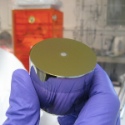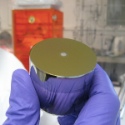New limits on dark matter
Over the past decade, the DAMA and DAMA/LIBRA experiments have published evidence that their particle detectors, which are buried deep beneath the Gran Sasso mountain in Italy, record an annual modulation in signal. The possibility that the modulation comes from unknown particles that make up the dark matter of the universe has made the result exciting—and controversial. In particular, scientists speculated that the effect could be consistent with the orbiting earth passing through a halo of weakly interacting massive particles (WIMPs). Although other dark matter searches mostly ruled out this possibility, they used detectors that would not have been sensitive to very light WIMPs (that is, with masses less than ) or certain types of interactions between the WIMPs and the nuclei in the detectors.
The COUPP Collaboration ruled out this possibility for the case where these interactions with the nuclei in the detector were spin-dependent. Now, the CoGeNT Collaboration reports in Physical Review Letters on limits for the case of spin-independent WIMP-nucleus interactions, effectively ruling out this case also.
In combination with the earlier results, these findings suggest that the annual modulation effect reported by DAMA cannot be explained by a halo of standard WIMPs. At this point, the source of this effect and its possible connection with dark matter remains unresolved. — Stanley Brown





